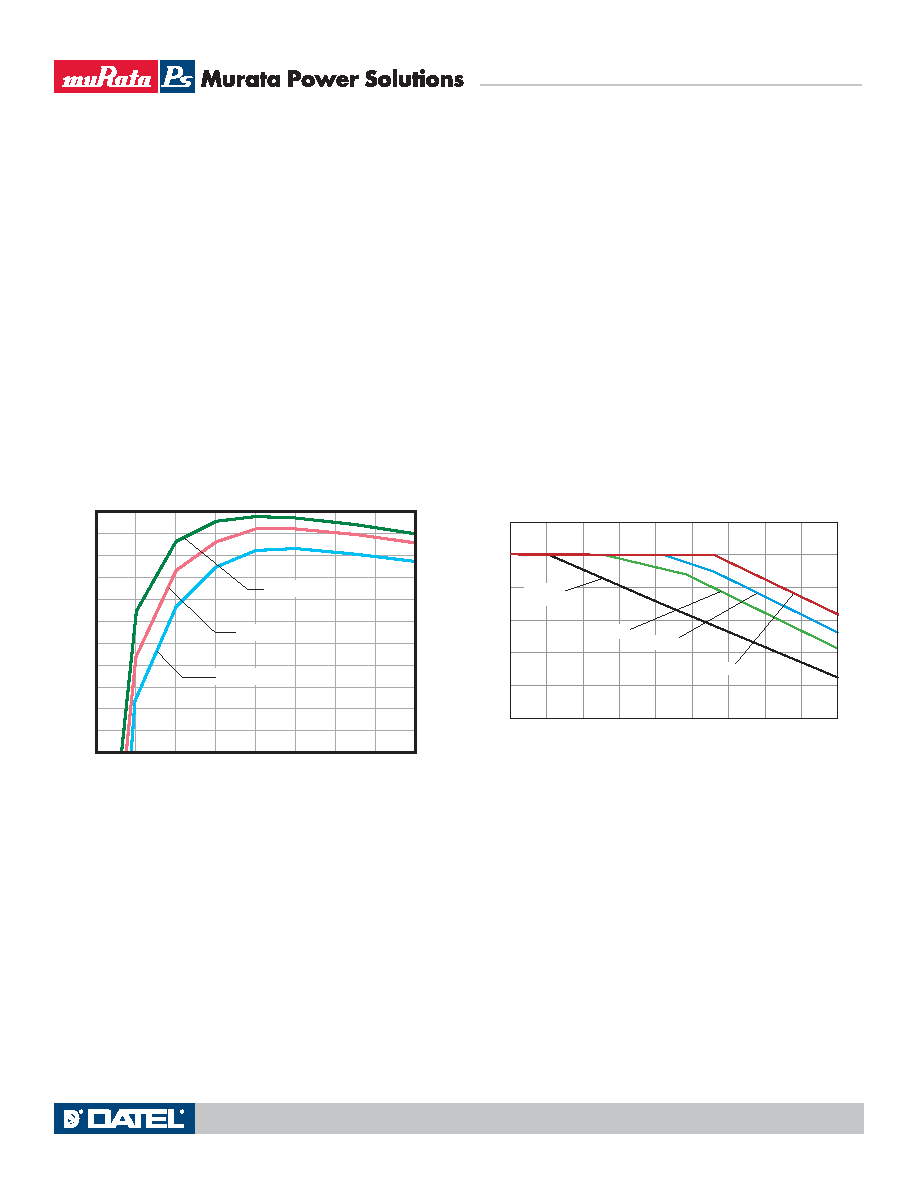- 您現(xiàn)在的位置:買賣IC網(wǎng) > PDF目錄44729 > LQN-2.5/45-D12-C (MURATA POWER SOLUTIONS INC) DC-DC REG PWR SUPPLY MODULE PDF資料下載
參數(shù)資料
| 型號(hào): | LQN-2.5/45-D12-C |
| 廠商: | MURATA POWER SOLUTIONS INC |
| 元件分類: | 電源模塊 |
| 英文描述: | DC-DC REG PWR SUPPLY MODULE |
| 封裝: | ROHS COMPLIANT PACKAGE-10 |
| 文件頁數(shù): | 2/15頁 |
| 文件大?。?/td> | 311K |
| 代理商: | LQN-2.5/45-D12-C |

Power derating (output current limiting) is based upon maximum output cur-
rent and voltage at the converter's output pins. Use of trim and sense functions
can cause the output voltage to increase, thereby increasing output power
beyond the converter's specied rating. Therefore:
(VOUT at pins) x (IOUT) ≤ rated output power
The internal 10.5
: resistor between +Sense and +Output (see Figure 1)
serves to protect the sense function by limiting the output current owing
through the sense line if the main output is disconnected. It also prevents
output voltage runaway if the sense connection is disconnected.
Note: If devices have the +Sense pin (pin 10) installed (no part-number
sufx) and the sense function is not used for remote regulation, +Sense
(pin 10) must be tied to +Output (pin 7, 9) at the DC/DC converter pins.
Output overvoltage protection is monitored at the output voltage pin, not
the Sense pin. Therefore, excessive voltage differences between VOUT and
Sense in conjunction with trim adjustment of the output voltage can cause the
overvoltage protection circuitry to activate (see Performance Specications for
overvoltage limits). Power derating is based on maximum output current and
voltage at the converter's output pins.
Temperature/power derating is based on maximum output current and volt-
age at the converter's output pins.
The Trim pin (pin 2) is a relatively high impedance node that can be suscep-
tible to noise pickup when connected to long conductors in noisy environments.
In such cases, a 0.22μF capacitor to ground can be added to reduce this long
lead effect.
Typical Performance Curves
LQN D12 Models
Non-Isolated, Single Output, 12VIN, 0.8-5VOUT
45-50 Amp, -Brick, DC/DC Converters
www.murata-ps.com
email: sales@murata-ps.com
2009.09.14
MDC_LQN D12 Models.B04 Page 10 of 15
相關(guān)PDF資料 |
PDF描述 |
|---|---|
| LQN-1.5/50-D12-C | DC-DC REG PWR SUPPLY MODULE |
| LQN-1.5/50-D12M | DC-DC REG PWR SUPPLY MODULE |
| LQN-5/45-D12MB | DC-DC REG PWR SUPPLY MODULE |
| LQN-2/50-D12M | DC-DC REG PWR SUPPLY MODULE |
| LQN-3.3/45-D12MB | DC-DC REG PWR SUPPLY MODULE |
相關(guān)代理商/技術(shù)參數(shù) |
參數(shù)描述 |
|---|---|
| LQN2A18NM04M00 | 制造商:MUR 功能描述:LQN2A18NM04M00 |
| LQN2A47NM04M00 | 制造商:Murata Manufacturing Co Ltd 功能描述: |
| LQN2A56NM04M | 制造商:Murata Manufacturing Co Ltd 功能描述: |
| LQN2AR15K04M00 | 制造商:MUR 功能描述:IND |
| LQN2AR15K04M00-01 | 制造商:Murata Manufacturing Co Ltd 功能描述:1 ELEMENT, 0.15 uH, ALUMINA-CORE, GENERAL PURPOSE INDUCTOR, SMD |
發(fā)布緊急采購(gòu),3分鐘左右您將得到回復(fù)。